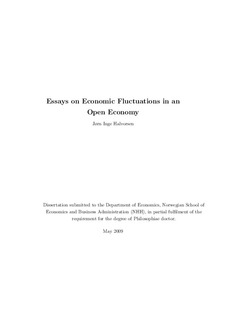Essays on economic fluctuations in an open economy
Doctoral thesis
Permanent lenke
http://hdl.handle.net/11250/163530Utgivelsesdato
2009Metadata
Vis full innførselSamlinger
Sammendrag
In assessing the present situation numerous influential international researchers have taken the view that macroeconomic researchers today largely have converged on the use of its methodology. For the study on economic fluctuations, the current research program is described to be about developing empirically validated quantitative models that can sensibly be used in counterfactual policy analysis.
The first chapter of the dissertation gives an historical outline on how this research program came about; the author looks particularly at how observed facts and economic theory have played a role in shaping the process. The remaining chapters of the dissertation consist of three essays that seek to make contributions to the program; each focusing on a particular area in which major disagreement exists.
In the first essay, an identification scheme that combines short term and zero restrictions is developed, and it is argued for why such a scheme is able to mitigate the problems associated with earlier identification schemes commonly used to identify structural shocks in a vector autoregressive (VAR) model.
In the second essay, the identification scheme developed in first essay is applied to study the question how does monetary policy response to exchange rate movements. For the six open economies in the study, strong empirical support that monetary policy makers respond quickly and strongly to exchange rate is found. Further, in relation to monetary policy shocks, support for the conventional overshooting hypothesis is confirmed. Both results deviate sharply from what is found in many previous empirical studies.
In the final essay, portfolio holding and the risk premium for nominal bonds is analyzed within a dynamic stochastic general equilibrium model for a small open economy. In particular, the analysis focuses on the properties of the risk premium and how this is affected by changes in the inflation targeting rule applied by the central bank. It is argued that these properties are at odds with modeling the risk premium as an exogenous stochastic process; a modeling approach that is common for many of today’s central banks.
